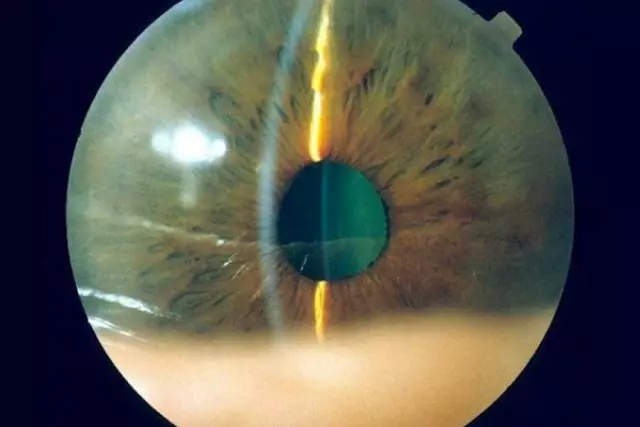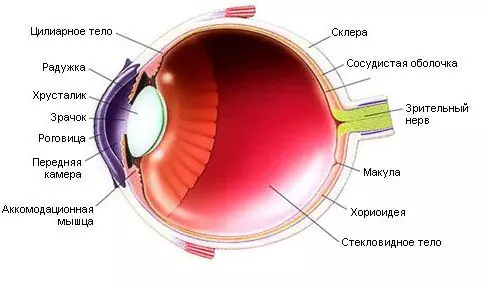- Author Rachel Wainwright [email protected].
- Public 2023-12-15 07:39.
- Last modified 2025-11-02 20:14.
Ozurdeks
Ozurdeks: instructions for use and reviews
- 1. Release form and composition
- 2. Pharmacological properties
- 3. Indications for use
- 4. Contraindications
- 5. Method of application and dosage
- 6. Side effects
- 7. Overdose
- 8. Special instructions
- 9. Application during pregnancy and lactation
- 10. Use in childhood
- 11. Drug interactions
- 12. Analogs
- 13. Terms and conditions of storage
- 14. Terms of dispensing from pharmacies
- 15. Reviews
- 16. Price in pharmacies
Latin name: Ozurdex
ATX code: S01BA01
Active ingredient: dexamethasone (Dexamethasone)
Producer: Allergan Pharmaceutical Ireland (Ireland)
Description and photo update: 03.10.2019
Prices in pharmacies: from 54,900 rubles.
Buy

Ozurdex is a glucocorticosteroid (GCS), a drug for topical use in ophthalmology.
Release form and composition
The drug is available in the form of an implant for intravitreal administration: a white or almost white rod [1 pc. in a plastic applicator (body with protective cap made of polycarbonate, stainless steel hypodermic needle of 22 gauge, actuator and retainer) in the form of a pen, in a laminated aluminum foil bag 1 applicator and 1 container with desiccant, in a cardboard box 1 bag and instructions on the use of Ozurdeks].
1 intravitreal implant contains:
- active substance: micronized dexamethasone - 0.7 mg;
- auxiliary components: copolymer of lactic and glycolic acids (50/50 SMGK acid) - 0.35 mg; copolymer of lactic and glycolic acids (50/50 SMGK ether) - 0.116 mg.
Pharmacological properties
Pharmacodynamics
Ozurdex is a glucocorticosteroid drug for topical use in ophthalmologists. The mechanism of action of the drug is due to the properties of its active substance, dexamethasone, aimed at suppressing the processes of inflammation and expression of the vascular endothelial growth factor, lowering capillary permeability and migration of phagocytes to the site of inflammation, reducing the severity of edema and fibrin deposition.
The drug prevents the release of prostaglandins, which are mediators of cystoid macular edema.
Pharmacokinetics
After intravitreal administration of dexamethasone at a dose of 0.7 mg in 86% of patients, its plasma concentration was below the limit of quantitative determination (0.05 ng / ml). The maximum concentration of dexamethasone in plasma can reach 0.094 ng / ml.
The greatest amount of dexamethasone is found in the retina, then in decreasing order - in the iris, ciliary body, vitreous fluid, aqueous humor and plasma. In the vitreous body, dexamethasone can be determined within 6 months from the moment Ozurdex was administered. The half-life (T 1/2) from the vitreous body is approximately 3 hours. The rate of excretion from the vitreous body is approximately 12 ml / day. It is metabolized to the final water and fat-soluble metabolites, which are excreted in the urine and bile.
Indications for use
The use of Ozurdex in ophthalmology is indicated for macular edema resulting from occlusion of the central retinal vein or its branches.
Contraindications
Absolute:
- herpetic (herpes simplex) epithelial keratitis (treelike keratitis), vaccine, chickenpox, mycobacterial infections, fungal diseases and other ocular or periocular infections (active or suspected);
- advanced stage of glaucoma, when the use of only drug therapy does not allow controlling the disease;
- breastfeeding (since there are no data on the excretion of the drug in breast milk);
- age up to 18 years;
- hypersensitivity to drug components.
Ozurdeks should be used with caution in ophthalmology with a history of herpetic eye infections (herpes simplex), aphakia, concomitant use of anticoagulants or antiplatelet agents, during pregnancy.
Ozurdeks, instructions for use: method and dosage
The implant in the applicator is intended for a single intravitreal injection, which involves the injection of the active substance directly into the vitreous body.
The procedure should be performed by a qualified ophthalmologist under controlled aseptic conditions using a sterile surgical drape, gloves and eyelid dilator.
The injection should be performed with an adequate degree of anesthesia. Before the procedure, it is imperative to apply a local broad-spectrum antimicrobial drug and a local antiseptic to the conjunctiva.
Having taken out the bag with the applicator from the cardboard box, you need to make sure that it is intact (it is prohibited to use it if there is any damage). The package should be opened in a sterile field, after which, after placing the applicator in a sterile tray, carefully remove the protective cap. While holding the applicator in one hand, carefully pull out the safety petal, avoiding bending or twisting.
Bringing the needle straight to the sclera, advance it about 1 mm into the sclera. Then, directing the applicator to the center of the eye, advance the needle into the vitreous cavity until the silicone sleeve of the needle contacts the conjunctival surface. To push the implant through the needle, slowly press the button on the applicator until you hear a click. Before removing the applicator from the eye, make sure that its button is fixed flush with the surface of the applicator body. The needle should be withdrawn in the reverse order of the insertion, and then follow the standard post-injection procedures.
Recommended dosage: 1 implant with an interval of at least 6 months.
While maintaining the improvement in visual acuity achieved in the patient during treatment, re-appointment of the Ozurdex injection is not required. In cases where a decrease in visual acuity is observed after a response to treatment, the drug can be re-prescribed if, in the doctor's opinion, the therapeutic effect of a repeated injection outweighs the potential risk to the patient's health.
It should be borne in mind that there is no experience with more than two implants in macular edema due to occlusion of the central retinal vein or its branches.
If, after the first injection of Ozurdex, the deterioration of visual acuity does not slow down, then its repeated administration is inappropriate.
After a single injection, the therapeutic effect to prevent vision loss is observed only after a month, reaches a maximum after two months and remains statistically significant up to three months.
Side effects
The unwanted disorders of Ozurdex described below are classified as follows: very common (≥ 1/10); often (from ≥ 1/100 to <1/10); infrequently (from ≥ 1/1000 to <1/100); rarely (from ≥ 1/10 000 to <1/1000); very rare (<1/10 000); the frequency has not been established - it is impossible, based on the available data, to establish the frequency of occurrence of adverse reactions:
- from the nervous system: often - headache;
- on the part of the organ of vision: very often - conjunctival hemorrhage (caused directly by the injection procedure), increased intraocular pressure; often - cataract, ocular hypertension, subcapsular cataract, detachment of the vitreous body, hemorrhage into the vitreous body during the procedure, visual disturbances in the form of a spot, line or darkening; phenomena caused by the injection procedure itself - conjunctival edema, conjunctival hyperemia, eye pain, opacity of the vitreous humor (including floating opacities of the vitreous humor), photopsia, cellular infiltration of the anterior chamber of the eye; infrequently (caused directly by the injection procedure) - opalescence of the aqueous humor of the anterior chamber of the eye, retinal rupture; frequency not established - endophthalmitis.
Overdose
Ozurdex overdose symptoms have not been established.
In case of an overdose, it is recommended to carefully monitor the intraocular pressure, in case of its increase, prescribe symptomatic treatment.
special instructions
Any injection into the vitreous cavity is associated with the risk of developing complications such as inflammation of the membranes of the eye, endophthalmitis, increased intraocular pressure, and retinal detachment. During its implementation, it is necessary to follow the rules of asepsis and carefully monitor the patient's condition after the implant is inserted.
Immediately after injection of Ozurdex, it is recommended to assess the perfusion of the optic nerve head. Ophthalmotonometric examination is carried out during the first 0.5 hours, eye biomicroscopy - every day from the second to the seventh day from the date of injection.
Against the background of the use of GCS, the risk of posterior subcapsular cataract, glaucoma, or secondary eye infections increases.
The development of cataracts was more often noted with wearing phakic lenses after re-injection.
An increase in intraocular pressure is most often seen in patients under the age of 45.
It should be borne in mind that while taking anticoagulants or antiplatelet agents, the risk of developing conjunctival hemorrhage or other hemorrhagic complications increases.
It is not recommended to carry out the simultaneous administration of Ozurdex in both eyes due to the lack of information on the effectiveness and safety of such a procedure.
In patients with macular edema secondary to retinal vein occlusion with severe retinal ischemia, the use of Ozurdex has not been studied, therefore, it is not recommended to prescribe it to this category of patients.
Influence on the ability to drive vehicles and complex mechanisms
After the introduction of Ozurdex, you should temporarily refrain from driving and engaging in other potentially hazardous activities due to possible temporary impairment of vision. It is allowed to resume work only after complete restoration of vision.
Application during pregnancy and lactation
The use of Ozurdex during the gestation period is allowed only in cases where, in the opinion of the doctor, the benefits of therapy for the mother are higher than the potential risk to the fetus.
If the use of dexamethasone is necessary during lactation, breastfeeding should be interrupted during therapy.
Pediatric use
The use of Ozurdex is contraindicated for the treatment of patients under the age of 18 years.
Drug interactions
Against the background of minimal systemic absorption with local application of dexamethasone, the interaction of Ozurdex with other drugs is unlikely.
Analogs
Ozurdex analogs are: Dexazone, Dexamed, Dexamethasone, Oftan Dexamethasone, Dexamethasone-Betalek, Dexamethasone-Vial, Dexamethasone-LENS, Dexamethasone-MEZ, Dexamethasone-Ferein, Dexamethasonelongidex, Maxxan and dr.
Terms and conditions of storage
Keep out of the reach of children.
Store at temperatures up to 25 ° C.
The shelf life is 3 years.
Terms of dispensing from pharmacies
Dispensed by prescription.
Reviews about Ozurdeks
Reviews about Ozurdeks are rare, their content does not allow us to conclude about the effectiveness of the drug.
Price for Ozurdex in pharmacies
The price for Ozurdex for a package containing 1 implant for intravitreal administration varies between 53,900-81,288 rubles.
Ozurdeks: prices in online pharmacies
|
Drug name Price Pharmacy |
|
Ozurdex 0.7 mg intravitreal implant 1 pc. RUB 54,900 Buy |

Anna Kozlova Medical journalist About the author
Education: Rostov State Medical University, specialty "General Medicine".
Information about the drug is generalized, provided for informational purposes only and does not replace the official instructions. Self-medication is hazardous to health!






